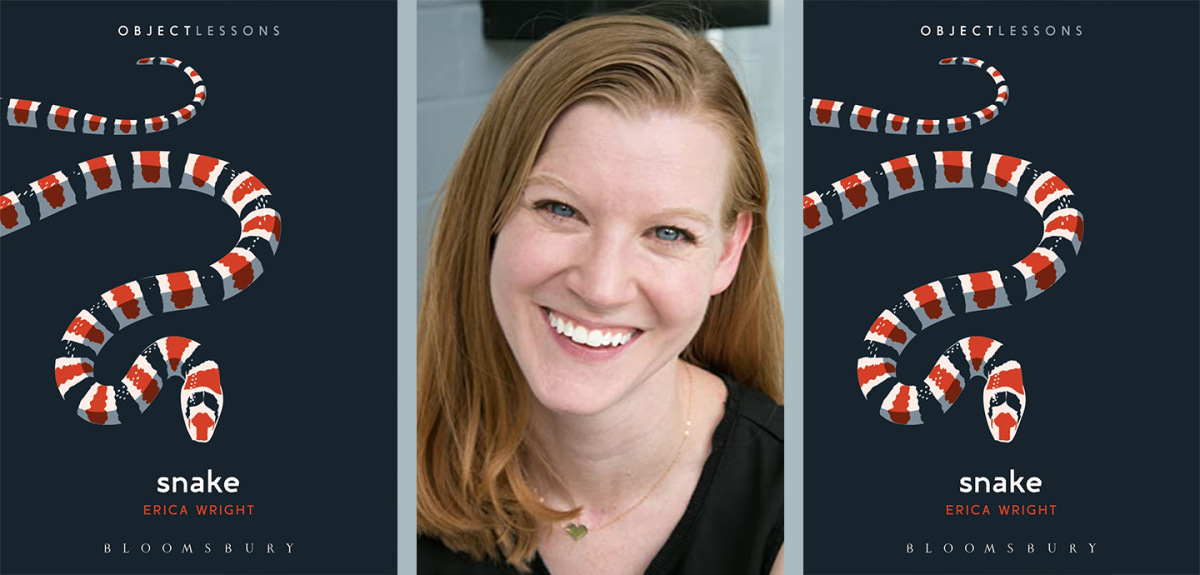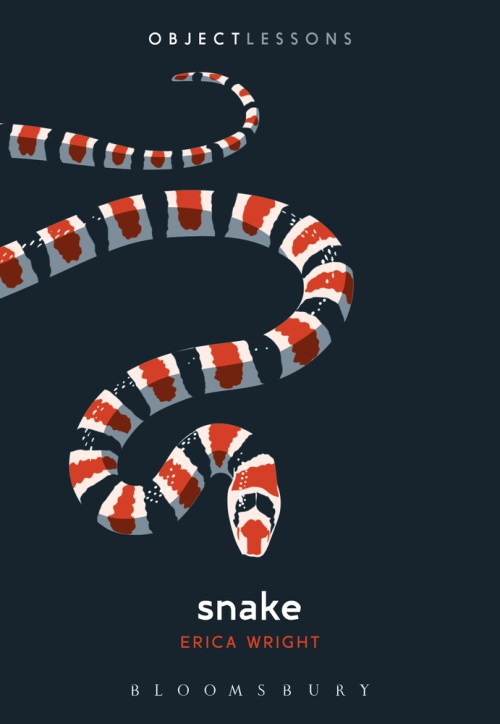[ad_1]
Few writers have attempted to connect the art of Britney Spears to the pictorial language of early cave dwellers, or to the religious rituals of fringe Christian groups, but that’s exactly what poet, mystery novelist, and essayist Erica Wright achieved with her book, Snake, one of the latest editions to Bloomsbury’s Object Lessons series.
Comprised of essays about one of the world’s most feared reptiles, Snake explores how the animal has conjured throughout time and around the world feelings of power, fear, evil, and hope, while being seen as an ominous omen, religious symbol, and sign of ecological disaster. Few other animals, we learn, have come to represent so many different aspects of human experience.
I spoke with Wright about what inspired her to write the book, why snakes continue to capture people’s imaginations in such a variety of ways, and how writing this book helped her to gain a new appreciation for the slithery, scaly animal.

Amy Brady
For folks who might be unfamiliar with Bloomsbury’s Object Lessons series, can you tell us a bit about it?
Erica Wright
I’m such a fan of this series and still pinching myself that I get to be a part of the Object Lessons roster. Basically, a writer takes a subject—such as refrigerators, dust, or luggage—and looks at it from a variety of lenses. There’s usually an element of memoir incorporated, as well. In High Heel, Summer Brennan talks about her time working for the United Nations, and in Veil, Rafia Zakaria begins by reflecting on her wedding. Most recently, I read Kenneth R. Rosen’s Bulletproof Vest, and he includes his experience as a war correspondent.
Amy Brady
Your book is about snakes (and what a beautiful cover, by the way.) What inspired you to think of snakes as “objects”?
Erica Wright
The cover was designed by Alice Marwick, and I love it. The image is a Western shovelnosed snake, which features prominently in a chapter that discusses research being conducted at Georgia Tech. The Complex Rheology and Biomechanics (CRAB) lab has received some national attention for their work with sidewinder rattlesnakes, but the pretty little shovelnosed has been equally important in their understanding of how animals navigate tricky terrains and how that might be applied to robotics.
I was worried that the series wouldn’t go for a deep-dive into an animal (although they do have one on whale song by Margret Grebowicz), but the snake has been treated as an object for centuries in religion and art as well as turned into an object by fashion houses. It exists as a symbol on every continent save Antartica and—most interesting to me—often holds a duality. It’s a symbol of both good and evil, life and death, danger and healing.
Amy Brady
Why do you think those dualities exist? Or put another way, why are humans both fascinated and fearful of snakes?
Erica Wright
Partly, I think both the fascination and fear stems from their ability to move without legs. They almost look like ripples of water even when gliding on land. They do seem a little otherworldly or mythological. Like dragons. The African bush viper is particularly vivid and could be a scene-stealer in Game of Thrones. They also shed their skin in one long piece, which I’ll admit is a perfect metaphor for renewal. And we see serpents used as icons of rebirth in many cultures as frequently as they are icons of death. Unfortunately, viewing these creatures as symbols rather than animals has contributed to a lot of abuses. Some people really do believe that they’re evil when they’re just a part of healthy ecosystems. They have no idea that they’ve been immortalized by everyone from Michelangelo to Britney Spears.
Amy Brady
What surprised you most in your research for this book? Any fun snake facts you can share with us?
Erica Wright
I was most surprised by the medicinal uses of venom as well as the potential for new discoveries. Antivenin dates back to at least ancient Greece, but probably much earlier. Snake venom has been used to develop several drugs, including ACE inhibitors, which can be used to address high blood pressure and prevent heart attacks as well as strokes. And different toxins are being studied as treatment options for cancer, muscular dystrophy, and Alzheimer’s disease. Related to that, I definitely didn’t know that the original snake oil was actually a useful anti-inflammatory. Lakshmi Gandhi wrote about the history of snake oil salesmen for NPR, which is where I learned that Chinese workers brought over this treatment for aching joints in the 1800s. As the product gained notoriety, Americans tried to replicate it using rattlesnake oil (as opposed to Chinese water snake oil), which didn’t work. That certainly didn’t stop swindlers from hawking their wares, though.
Amy Brady
I read recently that snakes are Americans’ number one fear, topping even fears of heights and public speaking. So I have to ask, and be honest: Are you afraid of snakes?
Erica Wright
When I started this journey, I would have said snakes were my number one fear. I’ve never finished Raiders of the Lost Ark because of the pit scene. But when I learned about rattlesnake roundups—annual events in which rattlesnakes are caught by the thousands then slaughtered for entertainment—my fear was pricked with sympathy. More than sympathy, really. A little guilt at the way I’d previously viewed snakes. I’d never killed one, but I’d also never mourned one.
I decided to attend the Rattlesnake & Wildlife Festival in Claxton, Georgia, which had previously been a roundup, but is now an appreciation weekend. Between eating fried pickles and watching pageant contestants pose with vipers, I spoke with herpetologists who showed off some beautiful species, including an eastern indigo and a scarlet kingsnake. Young children had no problem touching their scales, so I thought I better not ruin the effect with shrieks. Over the years, my fear turned into fascination.
Amy Brady
Before writing SNAKE you published several mystery novels. What was it like to switch from fiction to essays? Did your writing process change? Did you discover anything new about yourself as a writer?
Erica Wright
This is the most fun I’ve ever had with a writing project. At least half of the process was research, so my mornings were spent talking to experts or reading articles and absorbing information. Honestly, the hardest part was deciding what to leave out of the book. Committing myself publicly—permanently—to views was a little nerve-wracking, especially in terms of religion, and serpents feature prominently in many religions. My chapter that delves into so-called signs following churches (more commonly known as serpent handling churches) made me conscious of the way I dismiss certain aspects of faith and embrace others. As someone who prays, who am I to discount the spiritual possibilities of, basically, danger? On the other hand, there have been some serious allegations of animal abuse in this tradition—especially in more recent decades—which makes me less willing to give leaders the benefit of the doubt.
Amy Brady
What’s next for you?
Erica Wright
I’ve been working on a new mystery novel that’s a retelling of Shakespeare’s Measure for Measure set around a serpent handling church. (I promised my agent no more snakes after this, and I hope I’m not a liar!) The play is timely in the way it portrays men abusing their positions of power to commit sexual assault without any consequences. There’s a chilling line after Angelo has promised that if Isabel sleeps with him, he will save her brother’s life. Isabel refuses and counters that she will tell everyone what he proposed. Angelo responds by saying, “Who will believe thee, Isabel?” It’s too familiar, right? Painfully familiar.
I saw a production of the play at the Alabama Shakespeare Festival when I was in high school, and it stuck with me. The casting was brilliant. Their Angelo was over-the-top handsome—at least to my little seventeen-year-old heart—and having not read the text before, I didn’t realize at first that he’s the villain. It would have been easy to make the actor look grotesque, but plenty of devils look like angels.

NONFICTION
Snake
By Erica Wright
Bloomsbury
Published September 3, 2020
[ad_2]
Source link

